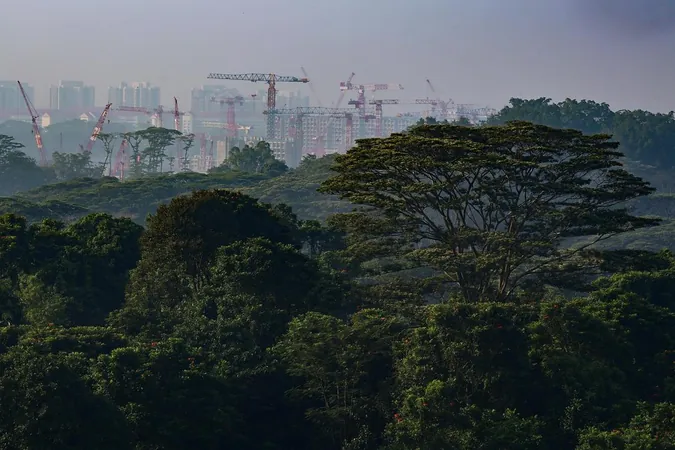
Alarming Rise in Carbon Emissions Signals Deforestation Concerns for Singapore
2024-12-22
Author: Siti
Alarming Rise in Carbon Emissions Signals Deforestation Concerns for Singapore
In a troubling forecast for Singapore's climate ambitions, the nation's carbon emissions from land use are projected to rise significantly by 2030, indicating a potential uptick in deforestation activities. While emissions from the land use sector currently represent a mere 0.06% of the total emissions in Singapore, the upcoming years could see these figures more than double, as revealed in a recent climate report submitted to the United Nations.
In 2022, emissions from land use, land use change, and the forestry sector were reported at 0.04 million tonnes of carbon dioxide equivalent (MtCO2eq). However, projections indicate a jump to 0.09 MtCO2eq by 2025, eventually reaching alarming levels of 0.14 MtCO2eq by 2030. This rise comes despite the government’s extensive reforestation initiatives, including the ambitious OneMillionTrees movement, which aims to plant a million trees by 2030. So far, more than 730,000 trees have been planted.
Historically, from 2000 until around 2014, Singapore's land use and forestry sector acted as a net carbon sink, absorbing more emissions than it emitted. Nevertheless, by 2014, this trend reversed as land use changes, including urban development and housing projects, began to erode the natural forest coverage. The data underpinning these emissions figures derive from previous satellite images, enabling projections toward 2030.
Experts stress that the declining capacity of Singapore's landscapes to capture carbon—a phenomenon not wholly unexpected—aligns with rapid urbanization and the conversion of forested areas into residential developments. Notably, land in Sembawang and Woodlands has been earmarked for housing projects, leading to the clearing of significant forest areas.
These removals often involve secondary forests, which, as noted by Assistant Professor Lim Jun Ying from the NUS Centre for Nature-based Climate Solutions, generally serve as vital carbon sinks due to their young, growing trees. Ironically, the land that has been cleared for development once supported a thriving ecosystem that absorbed carbon from the atmosphere.
While Singapore's urban greening efforts—including planting native trees that adapt to rainforest conditions—offer numerous ecological benefits, experts caution against purely viewing these initiatives through the lens of carbon emissions reduction. Urban planting can inadvertently release additional emissions during the saplings' growth phase, given the resources consumed in their cultivation and establishment.
Despite these challenges, Singapore's greening policies are essential not only for mitigating climate change but also for enhancing urban biodiversity, wildlife habitat connectivity, and improving residents' quality of life. Restoring green buffers and parks within urban settings, like Bishan-Ang Mo Kio Park, benefits local ecosystems and provides community recreation spaces while contributing to natural cooling in the city.
Moreover, restoring coastal mangroves emerges as a crucial strategy for countering future sea-level rises, as these ecosystems play an essential role in climate resilience. Overall, Singapore’s commitment to environmental sustainability tackles more than just emissions; it encompasses broad ecological values that are critical to the long-term health of both people and nature.
In conclusion, while the forecasted rise in carbon emissions from land use poses significant concerns, Singapore must continue to balance its urban development ambitions with crucial environmental objectives. Understanding that carbon capture is just one aspect of ecosystem health will be vital as the nation navigates its environmental strategies in a rapidly changing world.




 Brasil (PT)
Brasil (PT)
 Canada (EN)
Canada (EN)
 Chile (ES)
Chile (ES)
 España (ES)
España (ES)
 France (FR)
France (FR)
 Hong Kong (EN)
Hong Kong (EN)
 Italia (IT)
Italia (IT)
 日本 (JA)
日本 (JA)
 Magyarország (HU)
Magyarország (HU)
 Norge (NO)
Norge (NO)
 Polska (PL)
Polska (PL)
 Schweiz (DE)
Schweiz (DE)
 Singapore (EN)
Singapore (EN)
 Sverige (SV)
Sverige (SV)
 Suomi (FI)
Suomi (FI)
 Türkiye (TR)
Türkiye (TR)